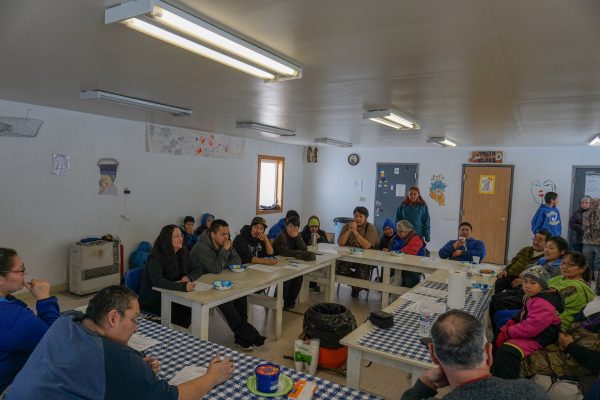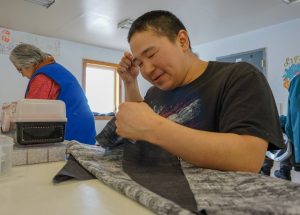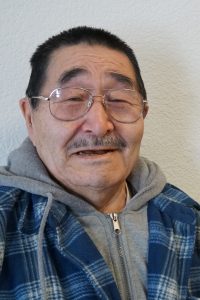
Ten-year-old August Seton sat in a small crowded community building in Hooper Bay surrounded by people of all ages, from little kids to elders. He clutched a piece of brightly colored fleece in his hand, slowly stitching the ends together.
“I’m gonna sew this way, and then turn it around and then go back that way,” he explained, pulling the thread taut.
He was making a face mask for his mom to block the cold coastal wind when she travels on a snow machine through their village and other parts of southwest Alaska.
For August, learning to sew isn’t just a practical skill. “I like about it because it reminds me of my grandma,” he said. “She used to like to sew. All the time.”
August was doing more than taking a sewing class. He was connecting with the people around him and remembering his family and his culture. He was participating in Qungasvik, a community-driven program that uses culture to help young people feel safer and more connected with their community.

The research the led to the development of Qungasvik started in the early 1990s in response to a series of Pulitzer Prize-winning articles by the Anchorage Daily News about alcohol abuse and suicide in rural Alaska. It told the story of a “People in Peril.”
Qungasvik project manager Cyndi Nation said those articles, and more recent ones, only tell part of the story of Alaska Native peoples.
“How many times do we hear about historical trauma? ‘You people are all drunks. You’re all this, you’re all that,’ she said. “And for a long time, we didn’t hear about the strengths that we all have.”
So Yup’ik elders from two communities in southwest Alaska invited researchers from the University of Alaska Fairbanks to help them develop interventions based on Yup’ik culture that would reduce the rates of suicide and substance abuse. The result was Qungasvik, which means toolbox in Yup’ik.
Unlike other suicide and substance use prevention programs that focus on the effects of trauma and looking for warning signs, Qungasvik focuses on the strengths that have helped people thrive in the region for millennia. It’s a framework developed by Yup’ik people for Yup’ik people, and it is adapted by people in each village to fit their local needs.
[Related: To prevent suicide, little words can make a big difference]
At the center of the model is the qasgiq, a traditional Yup’ik gathering space where in the past, people used to come together to make tools, discuss issues, and pass on knowledge. Each month, community leaders recreate a modern simulation of the qasgiq by sitting together in a circle around a pile of logs and a barrel of water. In this modern-day version, people from the tribe, local organizations, and others sit together to discuss what they want to teach their young people in the upcoming month. It varies significantly, depending on the season and what’s happening in the village.
In late winter in Hooper Bay, the group started talking about smelt fishing and ice conditions.
“It’s kinda slushy,” said Jan Olson, the tribal administrator. “It’s from the overflow. It’s still there. It doesn’t freeze because it’s salty. You need boots.”
The conversation wove together jokes about childhood games and information about gathering wood. It ends with a plan to teach young people how to make ice scoops and weave grass baskets, things that are useful in a coastal community when ice conditions start to change.
[Related: After a tragedy, a Yup’ik dance group in Hooper Bay keeps dancing]
But Qungasvik doesn’t just teach hands-on skills and craft making. During each session, elders provide advice on how to succeed.
As August sewed a face mask, elder Joseph Bell spoke to the group about safety in both English and Yup’ik.

“When you’re working with tools, any needles. You have to be aware of safety. Try not to hurt yourselves,” he said.
Elder Maria Bell reminded the young people that they are not in this alone — if you have a problem, tell someone about it.
“If you keep it to yourself, it’s going to create something in your head, making you feel down or feel like nobody wants you,” she said. “So it’s always best to have somebody.”
Surveys with young people show that participating the Qungasvik project makes them feel more like they do have somebody to tell. The young people take surveys before joining in activities and then again every six months. The data, collected at various points from six different villages over 10 years, shows that Qungasvik helps young people feel more connected to their communities and that life has meaning. Those are factors that reduce their suicide risk. The more the youth participate in activities, the more effective the program is. The published data show that the program isn’t as effective for reducing alcohol use.
 Jorene Joe directs the project in her home community of Hooper Bay. She said one of the main challenges she faces is recruiting adults to participate. Other local programs face the same problem.
Jorene Joe directs the project in her home community of Hooper Bay. She said one of the main challenges she faces is recruiting adults to participate. Other local programs face the same problem.
She said overall Qungasvik seems to be making a difference for the young people, though data collection in Hooper Bay isn’t as advanced as in other areas. She said she thinks it works because it doesn’t require people to do specific activities.
“It’s community driven, so we don’t have people coming in telling us to do certain things and we can just figure things out on our own as a community,” she said. “We have several entities that come together, we talk about issues that we’re having here, and then we resolve them amongst ourselves. Because who knows your community better than you?”
By focusing on reasons for living and lessons from elders, the young people are learning they are much more than a people in peril.
Want to hear more Solutions Desk stories? Subscribe to the podcast on iTunes, Stitcher, Google Play, or NPR.
After being told innumerable times that maybe she asked too many questions, Anne Hillman decided to pursue a career in journalism. She's reported from around Alaska since 2007 and briefly worked as a community radio journalism trainer in rural South Sudan.
ahillman (at) alaskapublic (dot) org | 907.550.8447 | About Anne




